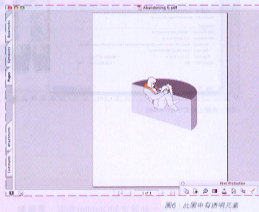Transparency Flattening
Many graphic design works use transparency effects. In fact, the printing world (whether digital or traditional printing) is not transparent or three-dimensional, but it is only transparent or stereoscopic. Postscript RIP for CtF, CtP, and digital printing cannot handle transparent objects. Some new prepress systems now include transparent processing functions. Before the RIP, transparent objects were planarized with the lower layers (equal to opacity). Perform RIP work; if you stop transparent processing, RIP encounters PDF with transparent objects and stops working or gives false warnings.
Some old systems do not have the function of transparency. At this time, we can use the Transparency Flattening tool to flatten the work. Click the relevant icon on the printing toolbar. In the Transparency Flattening window, we can see if there are any transparent objects in the file. Figure 7 Light red The colored area is the transparent object (and the affected area). We first select the object to be viewed, and then click Refresh to display the result. If there is a transparent object and you want to flatten it, you can push the Flattening Settings slider, left to vectorize the vector object, and keep the vector object to the right to avoid being rasterized. To rasterize an object is to planarize it. Therefore, the more the slider is to the left, the more objects will be flattened. Remember to click Apply after setting the options, otherwise flattening will not take effect. Finally, press OK.

There are transparent elements in this picture

Transparency Flattening to view and change transparent elements
PDF Optimizer
The PDF Optimizer on the print toolbar (the second on the right in the lower right corner of Figure 8) can optimize the PDF file, meaning to remove unnecessary or unnecessary stuff from the file, or to compress the image/downscale (down - Sampling) etc. The optimization settings depend on the purpose of use. For example, customers sometimes request that PDFs be sent to him for review after correction. However, PDFs may have several MB or more, so it is difficult to send them by email. If it is possible to reduce PDFs to a small size, it may be possible to send them by email. Depending on the contents of the PDF and the optimization settings, some can be significantly reduced and some can only be reduced. If the file has more bitmaps, there may be a significant reduction because the bitmap can be made smaller by JPEG or other compression methods.
PDF Optimizer has some settings similar to Distiller. To activate this function, click on the PDF Optimizer icon in the print toolbar. There is an Analyze button in the upper right corner of the dialog window. It can analyze the contents of the file and let us know that it takes up a lot of space. If the image occupies a large space, then the reduced image can reduce the space of the file. If the font takes up more space, then removing the font can reduce the capacity of the file. Of course, the original appearance of the file cannot be preserved (such as The other party's system does not have a corresponding font).
JDF Job Definitions
The final function of the printing tool column is the JDF editor. JDF is very similar to Adobe Extreme or some of the pre-press system Job Tickets, but it does not only include prepress information. It is equivalent to a very detailed printing work order, containing all print productions. Information, even accounting and shipping information. At present, JDF is still in its infancy and there are not many systems and equipment to support it. I am not going to talk about it here. If readers are interested, you can browse this page http:/// and you will get a lot of information.
Source: Graphic Arts 266 February 2006 Author /: CC Wong
Casual,Dresses
bossgoo Technology Co., Ltd. , http://www.bossgoodemo.com